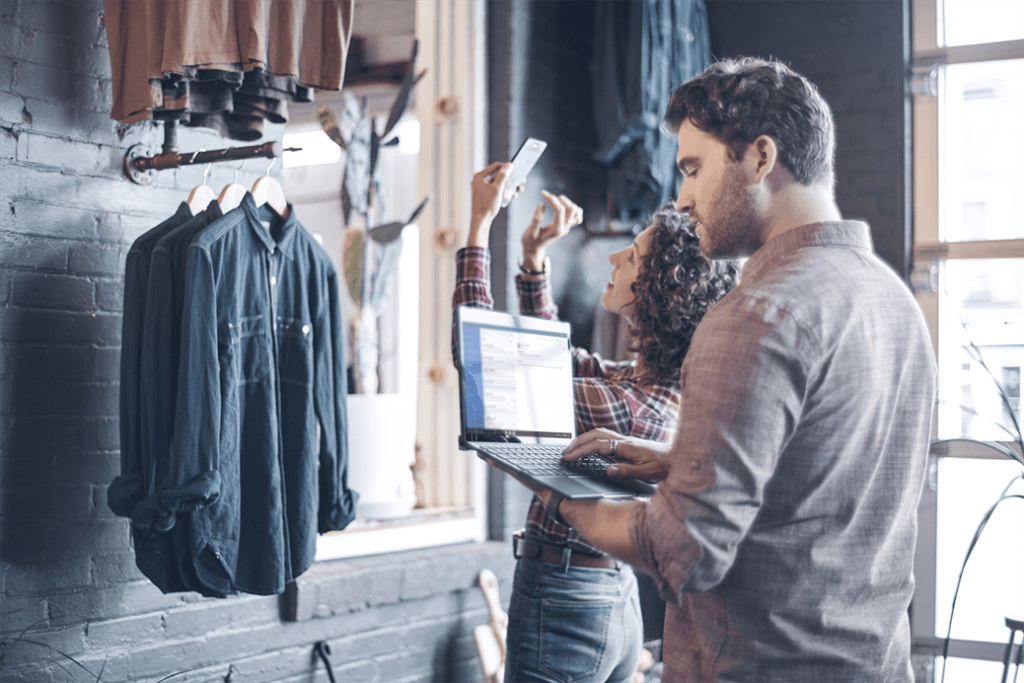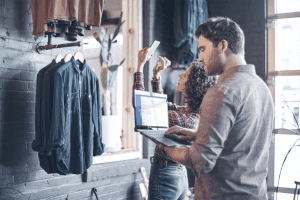
Equipping the store of the future
OnWindows Issue 6: Spring 2016
We find out how Microsoft and its partners are leveraging new technologies to help retailers create modern shopping experiences and empower employees to deliver a new level of customer service
In Pennsylvania, US, Gerrity’s Supermarkets has deployed a mobile app that enables customers to scan and bag groceries as they shop, and pay at an express checkout. Elsewhere, global snacks manufacturer Mondelez International has developed a Diji-touch vending machine powered by Microsoft Kinect, Windows 10 and Azure IoT to allow customers to interact with products in 3D.
These are just two of the retailers worldwide that are harnessing the power of newly affordable technologies – such as customer relationship management (CRM) systems, the cloud, analytics, beacons and touch-screen devices – to transform how they engage with individual consumers both in store and online.

“Retailers are switching from an onmnichannel business model to a unified commerce approach where the online and physical stores are merging and mobile is playing an increasing the integral role,” says Marty Ramos, Microsoft’s chief technology officer of retail, consumer products and services. “Today’s consumers want to be able to start their shopping trip on their laptop at home, continue on their mobile and then pick up where they left off when completing their purchase in store.”
To facilitate this, notes Susan Olivier, vice president of consumer goods and retail industry at Dassault Systèmes, retailers must provide customers with the same information and quality of service at all touch points.
“It’s essential that retailers replicate the same efficient and interactive experience they provide online in their high-street outlets,” she says. “In future, physical stores will feature self-serve kiosks, digital shelves and interactive touch screen displays where consumers can access detailed product information, view extended product assortments, or even order products.”
Juan Guitierrez Botella, director of the Avanade Retail Center of Excellence, adds that retailers must also merge previously separate e-commerce and in-store systems, and use the same customer and product data to support both online and in-store customer interactions. “Although physical stores will continue to play a vital role in the shopping journey, from an IT perspective, the concept of separate digital and physical stores is obsolete,” he comments.
It’s also imperative that retailers equip store associates with the tools they need to know everything about individual customers the moment they walk into a store.
“The simple trick to improving conversion rates is to use data about customers’ preferences to personalize their shopping experience,” advises Ramos, adding that CRM platforms, in-store sensors and analytics tools are vital for capturing data from all customer touch points. “For example, if a store associate can see that I’ve looked at a particular shirt online, they can take me straight to it and then analyze my purchase history to recommend related products. Meanwhile, in-store sensors can help retailers to track customers as they pass through the store, identifying prime opportunities to drive sales by delivering additional product information or tailored discounts directly to their smartphones.”
Ramos adds that store associates should also be able to complete all tasks – from collaborating with colleagues, to checking inventory and serving customers – via one device and one operational system.
Avanade’s Botella agrees: “Physical stores will expand to become customer service hubs that offer online order fulfilment and post-sales support, so retailers must invest in technologies that empower store associates to become customer service representatives, fulfilment experts and product researchers that are adept at solving any customer issue.”
To help its clients explore how Microsoft technology can be deployed to transform in-store business processes and customer experience, Avanade has recently founded a Retail Center of Excellence.
“We’ve used Microsoft Kinect to develop interactive displays and Microsoft SharePoint to build Digital Pinboard solutions that deliver information and training directly to store associates,” explains Botella. “We’ve also adopted Microsoft Modern POS to help retailers explore the next generation of in-store POS.”
Similarly, Dassault Systèmes is helping retailers to use 3D visualization technologies and touchscreen devices that could power digital fitting rooms, interactive product information displays and self-serve kiosks. In addition, the company has developed ‘My Store’, a visual merchandising and assortment planning solution to enable retailers to simulate retail displays 3D product images and create flexible store planograms that are informed by real-time business analytics.
“Often, retailers need to display a lot of products in a limited space, so it’s vital that they can quickly trial different store layouts in a virtual environment and make more informed decisions about everything from where to place products to maximize in-store sales, to the location of changing rooms,” says Olivier.
Certainly, technology will enable retailers to transform both their physical outlets and store associates into intelligent entities that work cohesively with their online and mobile channels to offer customers a personalized and seamless shopping journey across all touch points.
“Whether we’re installing on-premise edge servers, providing in-store beacons and analytics technology, or simply equipping store associates with personal devices, Microsoft and our partners are creating the homogenous technology ecosystem that will support the store of the future,” says Ramos. “Together, we’ll help retailers to offer customers memorable, immersive experiences that build loyalty and engagement, and drive new revenue opportunities.”
“From an IT perspective, the concept of separate digital and physical stores is obsolete” JUAN GUITIERREZ BOTELLA, AVANADE RETAIL CENTER OF EXCELLENCE
Profiled:
Building the supermarket of the future
 Last year, Avanade joined with Accenture, Intel, Microsoft and Italy’s largest supermarket chain, COOP Italia, to bring a Supermarket of the Future concept to Expo Milan. The concept, which was also exhibited at the National Retail Federation show this January, uses internet of things technologies, augmented reality capabilities, Microsoft Azure, Kinect and motion- and touch-sensitive devices and shelves to give customers additional information about products. This includes everything from where it was sourced, to allergen information. “Customers were impressed by the possibility of exploring all the possible details of the products with a simple hand gesture,” enthuses Juan Guitierrez Botella, director of the Avanade Retail Center of Excellence. “We’ll use this experience to help other retailers explore how digital interactivity can create a more informative and convenient in-store shopping experience.
Last year, Avanade joined with Accenture, Intel, Microsoft and Italy’s largest supermarket chain, COOP Italia, to bring a Supermarket of the Future concept to Expo Milan. The concept, which was also exhibited at the National Retail Federation show this January, uses internet of things technologies, augmented reality capabilities, Microsoft Azure, Kinect and motion- and touch-sensitive devices and shelves to give customers additional information about products. This includes everything from where it was sourced, to allergen information. “Customers were impressed by the possibility of exploring all the possible details of the products with a simple hand gesture,” enthuses Juan Guitierrez Botella, director of the Avanade Retail Center of Excellence. “We’ll use this experience to help other retailers explore how digital interactivity can create a more informative and convenient in-store shopping experience.
Solution Spotlight:
Personalizing products
Dassault Systèmes has recently launched ’My Retail Theatre’, a solution for retailers to provide consumers with the chance to customize their products via a 3DEXCITE configurator. Built on the 3DEXPERIENCE platform, it creates photo-realistic 3D models of products to enable customers to personalize products by changing colors, materials and textures via touch screen devices in a physical store or online. “Replacing physical stock with 3D digital photo-realistic images allows retailers to offer consumers an extended product assortment without increasing inventory or compromising on the quality of store displays,” explains Olivier. “In addition, retailers can gain insight into consumers’ tastes and trends and maximize their online engagement.” Last year, FashionLab by Dassault Systèmes joined with Julien Fournié, founder of France-based Couture House, to use the technology to design and customize a footwear collection using Microsoft Surface Pro devices.





